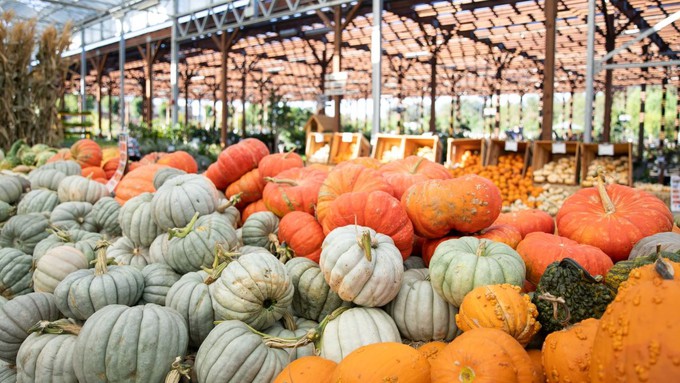
Patches now open at local nurseries; what to look for when pumpkin shopping

Just in time for Green Acres' annual Fall Festival, piles of pumpkins await shoppers at Green Acres Nursery & Supply. Photo courtesy of Green Acres Nursery & Supply www.idiggreenacres.com
It’s pumpkin time, as evidenced by brightly colored piles outside supermarkets and inside nurseries.
But how do you choose the perfect pumpkin? It depends on what you’re shopping for.
Most pumpkins now rolling into stores are for Halloween carving or decorative purposes. Most carving pumpkins – bright orange with thin rinds and smooth skin – are hybrids of Connecticut field pumpkin varieties – the classic heirloom pumpkin. It tends to weigh 15 to 20 pounds, giving these future Jack-o-lanterns some size but not too much heft.
Pumpkins with thin rinds or walls tend to be easier to carve than thick-walled varieties. How can you tell before you crack it open? Pick it up; does that pumpkin seem heavy for its size? If so, it’s thick walled. Also, look at the stem. Thick-walled pumpkins tend to have hefty, thick stems.
Thin or thick, choose a pumpkin that feels solid to the touch all the way around. Avoid any with soft spots or sunken areas; they’ve already begun to decay.
Fresh pumpkins can last several weeks if left uncarved and kept out of direct sun. But a carved pumpkin’s lifespan is mere days (if not less than 24 hours); those cut surfaces tend to mold or rot quickly.
Interest in uncarved pumpkins as fall decorations had led to a plethora of pumpkin varieties. For example, Green Acres Nursery & Supply stocks at least a dozen different varieties: Carving, Fairytale, Lumina, Lil’ Pump-Ke-Mon, Cinderella, Jarrahdale, Big Max, Cronus, Iron Man, Knucklehead, One Too Many and Lunch Lady plus mini pumpkins, winged gourds and gooseneck gourds.
Need carving and decorating ideas – or want to show off your own skill? As part of its Fall Festival on Saturday, Sept. 30, Green Acres is hosting a pumpkin decorating contest at each of its seven locations. Decorate and/or carve the pumpkin in advance and enter it before 9:30 a.m. at the store’s contest table. Categories include Scariest, Silliest and Most Creative. Winners will be announced Monday, Oct. 2.
Green Acres’ Fall Festival also includes pumpkin-inspired games, crafts and workshops including how to turn a pumpkin into a succulents planter. Festival hours are 9 a.m. to 4 p.m. Saturday; admission and parking are free.
Green Acres is located in Sacramento, Auburn, Citrus Heights, Elk Grove, Folsom, Rocklin and Roseville. For addresses, directions and more details on the Fall Festival: https://idiggreenacres.com/.
Comments
0 comments have been posted.Sacramento Digs Gardening to your inbox.
Sites We Like
Garden Checklist for week of May 5
Survey your garden after the May 4 rainstorm. Heavy rain and gusty winds can break the neck of large flowers such as roses. Also:
* Keep an eye on new transplants or seedlings; they could take a pounding from the rain.
* Watch out for powdery mildew. Warmth following moist conditions can cause this fungal disease to “bloom,” too. If you see a leaf that looks like it’s dusted with powdered sugar, snip it off.
* After the storm, start setting out tomato transplants, but wait on the peppers and eggplants (they want warmer nights). Pinch off any flowers on new transplants to make them concentrate on establishing roots instead of setting premature fruit.
* Trim dead flowers but not leaves from spring-flowering bulbs such as daffodils and tulips. Those leaves gather energy to create next year's flowers. Also, give the bulbs a fertilizer boost after bloom.
* Pinch chrysanthemums back to 12 inches for fall flowers. Cut old stems to the ground.
* Mulch around plants to conserve moisture and control weeds.
* From seed, plant beans, beets, cantaloupes, carrots, corn, cucumbers, melons, pumpkins, radishes and squash.
* Plant onion sets.
* In the flower garden, plant seeds for asters, cosmos, celosia, marigolds, salvia, sunflowers and zinnias. Transplant petunias, zinnias, geraniums and other summer bloomers.
* Plant perennials and dahlia tubers for summer bloom.
* Don’t wait; plant summer bulbs, such as gladiolus and tuberous begonias.
* Harvest cabbage, lettuce, peas and green onions.